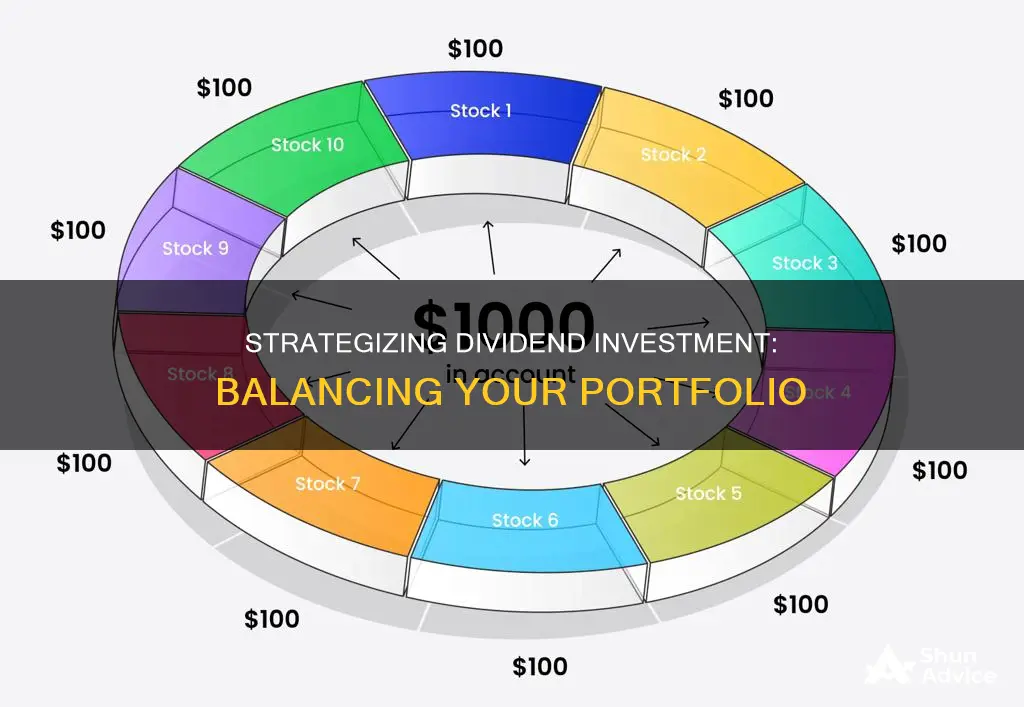
Dividend stocks are a great investment option for those looking for a steady stream of income and capital appreciation. They provide dual benefits of regular dividend payments and potential growth in the stock price. However, building a dividend portfolio requires careful consideration to balance risk and return. Here are some key guidelines to help you get started:
- Diversification: Hold between 20 and 60 stocks across different sectors to reduce company-specific and industry-specific risks. Avoid putting all your eggs in one basket, as it increases the volatility of your portfolio.
- Equal-Weight Holdings: Distribute your investments equally across your chosen stocks, as it's challenging to predict which holdings will perform the best in the long term.
- Sector Allocation: Invest no more than 25% of your portfolio in any one sector. This ensures that your portfolio is not overly exposed to the risks associated with a particular industry.
- Target Safe Dividends: Look for companies with a long history of paying reliable dividends, low leverage ratios, resilient earnings streams, and conservative payout ratios. Avoid companies with excessive debt, cyclical profits, and inconsistent cash flow generation.
- Reinvest Dividends: Consider reinvesting your dividend income back into your portfolio to accelerate growth through the power of compounding.
- Due Diligence: Conduct thorough research before investing. Evaluate companies based on key metrics like dividend yield, payout ratios, earnings per share, and price-to-earnings ratio.
- Risk Management: Regularly monitor your portfolio's performance, diversification, income generation, and potential risks to ensure it remains aligned with your investment objectives.
Building a well-balanced dividend portfolio takes time and discipline. Remember to stay informed, diversify your holdings, and make investment decisions that align with your risk tolerance and financial goals.
What You'll Learn

Diversify your holdings of good stocks
Diversifying your holdings of good stocks is a crucial aspect of building a robust dividend investment portfolio. Here are some detailed guidelines to help you diversify effectively:
Number of Stocks:
It is recommended to hold between 20 and 60 stocks in your portfolio to reduce company-specific risk. The more stocks you own, the closer your portfolio's returns will be to the market's average returns. Holding 25 stocks can reduce company-specific risk by about 80%, while holding 100 stocks can lower it by about 90%. During financial distress, you may need over 110 stocks to reduce risk effectively.
Equal-Weight Your Holdings:
It is generally advisable to roughly equal-weight each position in your portfolio. This is because it is challenging to predict which stocks will perform the best in the long term. By equal-weighting, you avoid the risk of over-relying on a few stocks that may underperform.
Sector Allocation:
It is recommended to invest no more than 25% of your portfolio in any one sector. For example, in the S&P 500, the Information Technology sector accounts for about 15% of the market. By diversifying across sectors, you reduce the risk of your portfolio being significantly impacted by negative factors affecting a particular industry.
Choose Safe Dividend Stocks:
Focus on companies with safe or very safe Dividend Safety Scores™. These are companies with low leverage ratios, resilient earnings streams, conservative payout ratios, time-tested operations, and long track records of paying reliable dividends. Avoid companies with too much debt, cyclical profits, inconsistent cash flow generation, and poor dividend coverage, as they are more likely to cut dividends during recessions.
Diversify Across Industries:
Diversify your weighting to include five to seven industries. For example, having all your investments in oil companies may seem appealing, but if oil prices drop, your portfolio value will be significantly impacted. By diversifying across industries, you reduce the likelihood of all your holdings being affected by industry-wide problems.
Kids' Guide to Saving and Investing Wisely
You may want to see also

Hold between 20 and 60 stocks
Holding between 20 and 60 stocks in your portfolio is a good way to reduce company-specific risk. This is known as diversification and is a key principle of investing. Diversification helps to balance risk and get you closer to your objectives.
The more stocks you hold, the more your portfolio's returns will reflect the market's returns. If you hold just a single stock, you will experience much greater volatility and deviation from the market's returns. According to the American Association of Individual Investors, holding 25 stocks reduces diversifiable risk by about 80%, while holding 100 stocks reduces it by about 90%.
However, holding more stocks also means more time spent on research and a higher number of trades, which may be impractical for individual investors. A portfolio of 20 to 60 stocks provides a reasonable balance between the need for diversification and the desire to keep trading activity low.
When constructing your portfolio, it is recommended to roughly equal-weight each position. This is because it is difficult to predict which stocks will be the best performers. By spreading your bets evenly, you avoid the risk of outsmarting yourself.
In addition to diversifying across stocks, it is also important to diversify across sectors. Try not to invest more than 25% of your portfolio in any one sector. This helps to reduce the risk of your portfolio being sensitive to shared factors, such as interest rates or the price of oil.
Gross Saving and Investment: Understanding the Basics
You may want to see also

Reinvest the dividends
Reinvesting dividends is a great way to build up your dividend investment portfolio over time. Here are some reasons why reinvesting dividends is a good idea and how you can go about doing it:
Benefits of Reinvesting Dividends
- Wealth accumulation: Reinvesting dividends allows you to buy more shares of the company or fund, helping you build wealth over time. The power of compounding means that your dividends buy more shares, which in turn increases your dividend the next time, and this cycle continues.
- Cost savings: Dividend reinvestment can be done without incurring commissions or other brokerage fees, making it a cost-effective way to accumulate more shares.
- Convenience: Setting up an automatic dividend reinvestment plan (DRIP) means that your dividends are automatically reinvested without any further action required from you.
- Flexibility: Dividend reinvestment plans often allow for the purchase of fractional shares, giving you the flexibility to invest the full dividend amount.
- Consistency: With dividend reinvestment, you are buying shares regularly and benefiting from dollar-cost averaging, which means buying more shares when prices are low and fewer when prices are high.
- Long-term growth: Reinvesting dividends is a great strategy if you are investing for the long term and don't need the dividend income immediately.
How to Reinvest Dividends
- Brokerage account settings: When setting up a brokerage account, you will usually be prompted to make a reinvestment election. You can choose to reinvest dividends or receive them as cash.
- Automatic dividend reinvestment plans (DRIPs): You can set up a DRIP through your broker or the issuing fund company. This ensures that all dividends paid are automatically used to purchase more shares of the underlying investment. Many brokers offer DRIPs at no additional charge.
- Company dividend reinvestment plans: Many publicly traded companies offer dividend reinvestment plans (DRIPs) that allow you to use dividend payments to purchase shares directly from the company, sometimes at a discount.
- Retirement plans: If you invest through a company-sponsored retirement plan, such as a 401(k), the plan administrator will typically set up the account to automatically reinvest dividends.
Hong Kong Savings: Best Places to Invest Your Money
You may want to see also

Target companies with safe dividends
When building a dividend portfolio, it's important to target companies with safe dividends. Here are some detailed guidelines and strategies to help you target safe dividend companies:
Understand Dividend Safety
Firstly, it's crucial to understand the concept of dividend safety. A safe dividend is one that is unlikely to be cut or suspended by the company. Dividend cuts usually occur when companies face financial difficulties or economic downturns. Therefore, it's important to assess the financial health and stability of a company before investing.
Assess Financial Health and Stability
When targeting companies with safe dividends, look for businesses with strong financial health and stable operations. Here are some factors to consider:
- Low Leverage Ratios: Companies with low debt levels are less likely to struggle with debt payments and have more financial flexibility to maintain their dividends.
- Resilient Earnings Streams: Seek companies with consistent and stable earnings. Avoid companies with highly cyclical or unpredictable profits, as they are more vulnerable to economic downturns.
- Conservative Payout Ratios: The payout ratio is the percentage of a company's earnings paid out as dividends. A conservative payout ratio, usually below 80%, indicates that the company is not overextending itself and has room to sustain dividend payments.
- Time-Tested Operations: Look for companies with a long history of stable operations and proven ability to navigate different economic cycles.
- Long Track Record of Dividend Payments: Companies with a long track record of consistently paying dividends, such as the S&P Dividend Aristocrats, tend to be more reliable in maintaining their dividend policies. However, even these companies may cut dividends during severe economic downturns, so always assess their current financial health.
Utilize Dividend Safety Scores and Ratings
To make informed decisions, consider using resources like Dividend Safety Scores™ or Morningstar's Economic Moat Ratings. These tools evaluate companies' financial metrics, management strategies, and dividend histories to assess the sustainability of their dividend payments. They can help you identify companies with a lower risk of cutting dividends.
Diversify Your Holdings
It's essential to diversify your portfolio across different sectors and industries. Avoid concentrating your investments in just one or two companies or sectors. By spreading your investments across a range of safe dividend companies, you reduce the risk of losing dividend income due to unexpected events or sector-specific downturns.
Monitor Performance and Developments
Once you've invested in safe dividend companies, it's crucial to regularly monitor their performance and any material developments. Stay updated on their financial health, earnings reports, and news that could impact their ability to sustain dividend payments. This proactive approach will help you identify potential risks and make timely adjustments to your portfolio if needed.
In summary, building a dividend portfolio with safe dividends involves targeting financially stable companies, diversifying your holdings, and staying vigilant in monitoring your investments. By following these guidelines, you can increase the likelihood of receiving steady dividend income and reduce the risk of dividend cuts.
Investment Savings: Average Amounts in the United States
You may want to see also

Avoid the yield trap
Dividend-paying stocks are often seen as higher quality and more stable than non-dividend-paying stocks. However, investors should be cautious of the "yield trap" or "dividend trap", where a company's dividend yield lures investors into risky corners of the market, exposing them to financial distress, dividend cuts, and share price declines. Here are some ways to avoid falling into the yield trap:
Unusually High Yield
An unusually high dividend yield might be a red flag that something is wrong with the business. However, do note that some companies, such as REITs and MLPs, are required to distribute a certain percentage of their income, so their yields may be legitimately high.
Excessive Debt
A company with excessive debt is more likely to cut its dividend during a tough economy. Evaluate the company's debt-to-equity ratio and compare it to similar companies in its industry.
Dividends Greater Than Earnings
A high payout ratio, especially over 100%, may indicate that a dividend isn't sustainable. The payout ratio is calculated as a company's annual dividend payout rate divided by its earnings.
Negative Cash Flow
Compare the dividend to the company's cash flow. Cash flow is the difference between the money coming into and going out of a business. If the dividend is higher than the cash flow, the company may not be able to sustain it.
Business Problems
Check the stock's price performance over the last year or two. If the high dividend yield is due to a rapid decline in the stock's price, investigate why. Also, look out for declining earnings or slowing earnings growth.
Payout Ratio
The payout ratio is how much of the company's net income is going to dividend payments. A payout ratio of over 100% means the company is paying out more than it is taking in, and it will be unable to maintain the dividend for long.
Lack of Cash
A company with little cash on hand may not be able to pay out dividends, or it may need to quickly raise cash, adding to its financial troubles.
History of Dividend Cuts
Look for companies with a history of dividend growth and no dividend cuts. A long history of raising dividends indicates that the company is likely to continue doing so in the future, assuming its business remains healthy.
Tracking Savings and Investments: Quicken's Smart Money Management
You may want to see also
Frequently asked questions
Dividend stocks offer dual benefits: income from dividends and capital appreciation, often outperforming with lower volatility.
Key metrics like dividend yield and payout ratios can help mitigate risks and assess dividend sustainability.
Holding between 20 and 60 stocks can help reduce company-specific risk and maximize the benefits of diversification.
It is recommended to roughly equal-weight each position to avoid putting too much weight on any single stock.
Invest no more than 25% of your portfolio in any one sector, and choose stocks from different sectors and industries to reduce risk.







